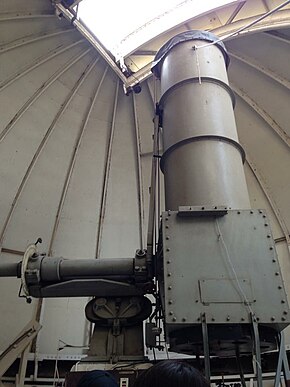 Mills telescope inside the observatory dome | |||
| Alternative names | Observatorio Manuel Foster | ||
|---|---|---|---|
| Location | San Cristóbal Hill, Santiago, Santiago Metropolitan Region, Chile | ||
| Coordinates | 33°25′20″S 70°37′57″W / 33.4221°S 70.6324°W | ||
| Altitude | 850 m (2,790 ft) | ||
| Established | 1903 | ||
| Website | astro | ||
| Telescopes | |||
| |||
| | |||
The Observatorio Manuel Foster, or Manuel Foster Observatory, is an astronomical observatory constructed on Cerro San Cristóbal near Santiago, Chile in 1903. This site was originally known as the D. O. Mills Observatory after the philanthropist Darius Ogden Mills. It was built as an offshoot of the Lick Observatory to observe stars in the southern hemisphere, and, under the direction of the American astronomer W. W. Campbell, was used in an extensive project to determine the apex of the Sun's motion through space.
The initial funding for the project financed operations for a two year period. Because Campbell had been seriously injured, the expedition was headed up by his assistant, William H. Wright. After setting up the telescope and the observation dome, the instrument quality was found to be satisfactory and operations began late in 1903. A total of 800 spectrograms had been successfully collected by October 1905. Heber D. Curtis took over operations in March 1906, and new financing from Mills allowed improvements to the observatory. Using the data collected from this observatory, Campbell completed his study on the motion of the Sun in 1926. With added funding, operations continued at the observatory until 1928, when it was purchased by Chilean lawyer Manuel Foster Recabarren for the Universidad Católica de Chile and transferred to their control.
The observatory is located in the Santiago Metropolitan Park and became a national monument in 2010. The main telescope is a cassegrain reflector with a 0.93 m (3.1 ft) aperture and an equatorial mount.[1] This instrument is housed inside a rotating dome.
